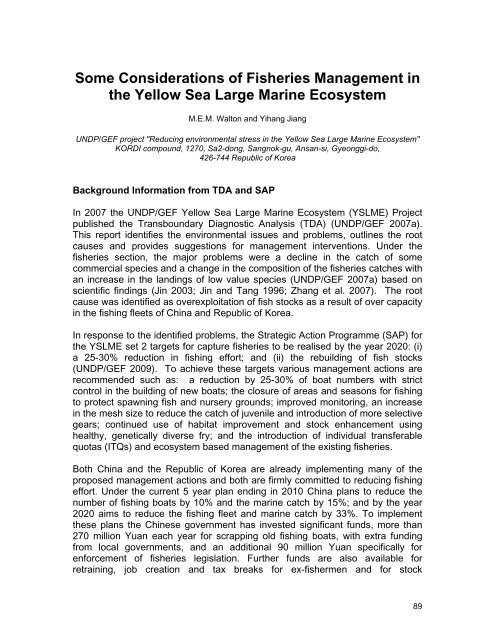Sustaining the World's Large Marine Ecosystems
Sustaining the World's Large Marine Ecosystems
Sustaining the World's Large Marine Ecosystems
Create successful ePaper yourself
Turn your PDF publications into a flip-book with our unique Google optimized e-Paper software.
Some Considerations of Fisheries Management in<br />
<strong>the</strong> Yellow Sea <strong>Large</strong> <strong>Marine</strong> Ecosystem<br />
M.E.M. Walton and Yihang Jiang<br />
UNDP/GEF project "Reducing environmental stress in <strong>the</strong> Yellow Sea <strong>Large</strong> <strong>Marine</strong> Ecosystem"<br />
KORDI compound, 1270, Sa2-dong, Sangnok-gu, Ansan-si, Gyeonggi-do,<br />
426-744 Republic of Korea<br />
Background Information from TDA and SAP<br />
In 2007 <strong>the</strong> UNDP/GEF Yellow Sea <strong>Large</strong> <strong>Marine</strong> Ecosystem (YSLME) Project<br />
published <strong>the</strong> Transboundary Diagnostic Analysis (TDA) (UNDP/GEF 2007a).<br />
This report identifies <strong>the</strong> environmental issues and problems, outlines <strong>the</strong> root<br />
causes and provides suggestions for management interventions. Under <strong>the</strong><br />
fisheries section, <strong>the</strong> major problems were a decline in <strong>the</strong> catch of some<br />
commercial species and a change in <strong>the</strong> composition of <strong>the</strong> fisheries catches with<br />
an increase in <strong>the</strong> landings of low value species (UNDP/GEF 2007a) based on<br />
scientific findings (Jin 2003; Jin and Tang 1996; Zhang et al. 2007). The root<br />
cause was identified as overexploitation of fish stocks as a result of over capacity<br />
in <strong>the</strong> fishing fleets of China and Republic of Korea.<br />
In response to <strong>the</strong> identified problems, <strong>the</strong> Strategic Action Programme (SAP) for<br />
<strong>the</strong> YSLME set 2 targets for capture fisheries to be realised by <strong>the</strong> year 2020: (i)<br />
a 25-30% reduction in fishing effort; and (ii) <strong>the</strong> rebuilding of fish stocks<br />
(UNDP/GEF 2009). To achieve <strong>the</strong>se targets various management actions are<br />
recommended such as: a reduction by 25-30% of boat numbers with strict<br />
control in <strong>the</strong> building of new boats; <strong>the</strong> closure of areas and seasons for fishing<br />
to protect spawning fish and nursery grounds; improved monitoring, an increase<br />
in <strong>the</strong> mesh size to reduce <strong>the</strong> catch of juvenile and introduction of more selective<br />
gears; continued use of habitat improvement and stock enhancement using<br />
healthy, genetically diverse fry; and <strong>the</strong> introduction of individual transferable<br />
quotas (ITQs) and ecosystem based management of <strong>the</strong> existing fisheries.<br />
Both China and <strong>the</strong> Republic of Korea are already implementing many of <strong>the</strong><br />
proposed management actions and both are firmly committed to reducing fishing<br />
effort. Under <strong>the</strong> current 5 year plan ending in 2010 China plans to reduce <strong>the</strong><br />
number of fishing boats by 10% and <strong>the</strong> marine catch by 15%; and by <strong>the</strong> year<br />
2020 aims to reduce <strong>the</strong> fishing fleet and marine catch by 33%. To implement<br />
<strong>the</strong>se plans <strong>the</strong> Chinese government has invested significant funds, more than<br />
270 million Yuan each year for scrapping old fishing boats, with extra funding<br />
from local governments, and an additional 90 million Yuan specifically for<br />
enforcement of fisheries legislation. Fur<strong>the</strong>r funds are also available for<br />
retraining, job creation and tax breaks for ex-fishermen and for stock<br />
89









